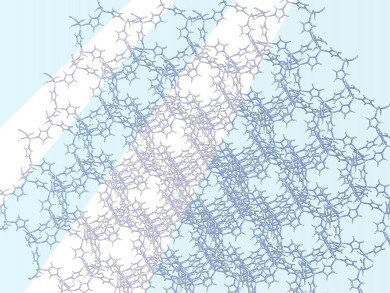Zeolitic imidazolate frameworks (ZIFs) are a common type of metal-organic framework (MOF). They consist of metal centers and imidazolate-based ligands. Some of these ZIFs can be melted at temperatures above 673 K and turn into a glass form when cooled again. However, ZIF-8 (pictured), a very commonly used MOF with the composition Zn(mIm)2 (mIm = 2-methylimidazolate), decomposes instead of melting when heated.
One approach to lower the melting point and obtain otherwise inaccessible liquid forms of compounds is flux melting, which is usually used in inorganic chemistry. In this method, a second compound is added, and the resulting mixture has a lower melting point than the pure substance.
Thomas D. Bennett, University of Cambridge, UK, have used flux melting to melt ZIF-8 and prepare a glass. The team prepared a mixture of ZIF-8 particles and ZIF-62 particles, which have the composition Zn(Im)1.75(bIm)0.25 (Im = imidazolate, bIm = benzimidazolate). The mixture was heated to 773 K and then cooled again to obtain a glass-like material.
The flux-melted glass retains some of the ordering in ZIF-62, but has a higher porosity than glass made from pure ZIF-62. The researchers attribute this to the ZIF-8 component. The mixed material also has an increased porosity towards H2 and CO2 gases, which could make it useful for free-standing membranes. According to the researchers, MOF glasses are chemically and structurally different from existing categories of melt-quenched glasses (inorganic, organic, and metallic).
- Flux Melting of Metal-Organic Frameworks,
Thomas Douglas Bennett, Louis Longley, Sean Michael Collins, Shichun Li, Glen Smales, İlknur Erucar, Ang Qiao, Jingwei Hou, Cara Doherty, Aaron W. Thornton, Anita Hill, Xiao Yu, Nick J. Terrill, Andrew J. Smith, Seth M. Cohen, Paul Midgley, David A. Keen, Shane Telfer,
Chem. Sci. 2019.
https://doi.org/10.1039/c8sc04044c



